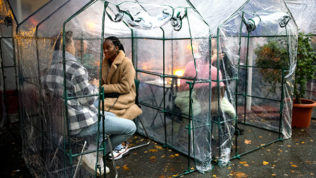Restaurants seeking new ways to stay operational during the pandemic are constructing temporary structures to extend the outdoor dining season. Yurts, plastic pods, greenhouses, shanties and tents are popping up as restaurants work to serve customers while limiting exposure to COVID-19.
Use of these structures without proper safety precautions and adequate protections for customers and employees could lead to unforeseen legal and safety consequences.
Before setting up temporary accommodations at your establishment, consult with local authorities, your attorney and your insurance agent. Here are some common considerations:
GENERAL LIABILITY
- Ensure the structure complies with all local building codes and zoning ordinances.
- If hiring a contractor to build the structure, treat it as if building a brick-and-mortar addition to the property.
- Insist on a contract that calls for the contractor to have insurance and language requiring the contractor to defend, indemnify and hold the business harmless should anything go wrong during the construction and erection of the structure.
- Obtain proof of professional errors and omissions liability insurance from any firm involved in the design of the structure.
- Ensure that the contractor who builds the structure can provide proof of completed operations insurance coverage to protect your business should the structure fail sometime after it is completed. Push for this completed ops coverage to last at least two years.
- Pay attention to the walking surface near structures placed in parking lots, on sidewalks or even in streets (with approval of local authorities.) Are there potholes, cracks or areas of heaved pavement that could cause employees and customers to trip?
- Notice the proximity of these outdoor structures to active traffic. What is the speed limit on the adjacent roadway? Is there adequate separation between traffic and the temporary structure to keep everyone in them safe? Will local authorities reduce the speed temporarily? Can the street be closed, or can you at least place cones or other warning devices to alert drivers to the presence of people so close to the street?
- Securely tape any electrical cords running through the structures or cover them with heavy-weight floor mats to prevent anyone from tripping and potentially tipping over heaters or light poles.
PROPERTY
One of the greatest property related concerns with temporary structures is the flammability of the tent fabric. Temporary structures should be constructed using only approved fabrics that comply with National Fire Protection Association standards. This will ensure proper flame resistance ratings. Local authorities likely will require a certificate showing that the tent materials meet NFPA-701 code.
Prior to setting up the temporary structure, consult local authorities for specific guidance on proper setup and placement of the structure. Items to consider:
- Whether buying and erecting a prefabricated structure or having the structure built to design specifications, ensure the structure is designed to withstand anticipated weather conditions. Know the maximum wind speed and snow load the structure can withstand.
- Placement of the structure should not obstruct egress from any buildings, fire department vehicle access or access to firefighting equipment such as hydrants, fire department connections and building sprinkler valves.
- Tent structures should allow at least 10 feet between stake lines for emergency egress.
- The immediate 10 feet around the structure perimeter should be free of combustibles and combustible storage.
- Limit fire hazards such as combustible storage or debris, smoking and heating equipment. Post NO SMOKING signs. Portable fire extinguishers required in the tent structure should be clear and accessible.
- Use only listed appliances, such as cooking and heating equipment.
- Locate containers for LP gas heaters at least 60 inches from the tent structure and comply with NFPA-58 Liquified Petroleum Gas Code.
- Connect electrical heaters to an electrical source suitable for outdoor use and adequately sized to handle the electrical load.
WORKERS’ COMPENSATION
One of the greatest workers’ compensation risks is the safe transportation of food to the outside eating area. When possible, consider the following guidelines for employee safety:
- Use carts to transfer items from restaurant to the outside area.
- Limit the need for employees to cross vehicular traffic patterns.
- Position the exterior eating area adjacent to the restaurant.
- Ensure employees receive rest when needed and understand to drink water on a regular basis.
- Provide some services in the tent such as warmers to store food items and drink preparation stations. If warmers or temporary food stations are used, are items filled in the kitchen and transferred in the warming unit? If so, is the path for travel of service equipment in good condition?
- Adjust to bad weather conditions. If possible, create shelter for servers leaving the restaurant and delivering food to the outside eating area.
- If heat inside the structure is being used, ensure proper ventilation for products of combustion.
- If the structure is covered, be sure openings are clear of debris and large enough for servers to enter easily. Additionally, ensure there are open traffic patterns between individual tent systems.
MORE INFORMATION
Centers for Disease Control and Prevention’s Considerations for Restaurant and Bar Operators
California Department of Public Health’s COVID-19 Industry Guidance for Restaurants
Occupational Safety and Health Administration Alert for Restaurants
National Fire Protection Association Building and Life Safety Issues for Tents
This loss control information is advisory only. The authors assume no responsibility for management or control of loss control activities. Not all exposures are identified in this article. Contact Landmark Risk Management & Insurance for coverage advice and policy service. Neither The Cincinnati Insurance Company nor its affiliates or representatives offer legal advice. Consult with your attorney about your specific situation.

